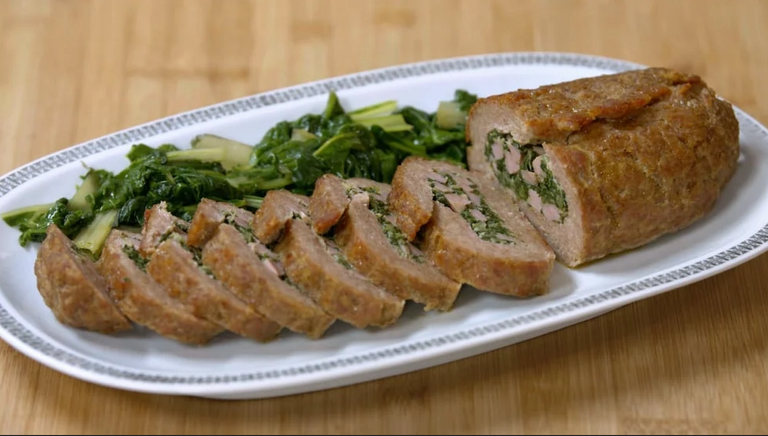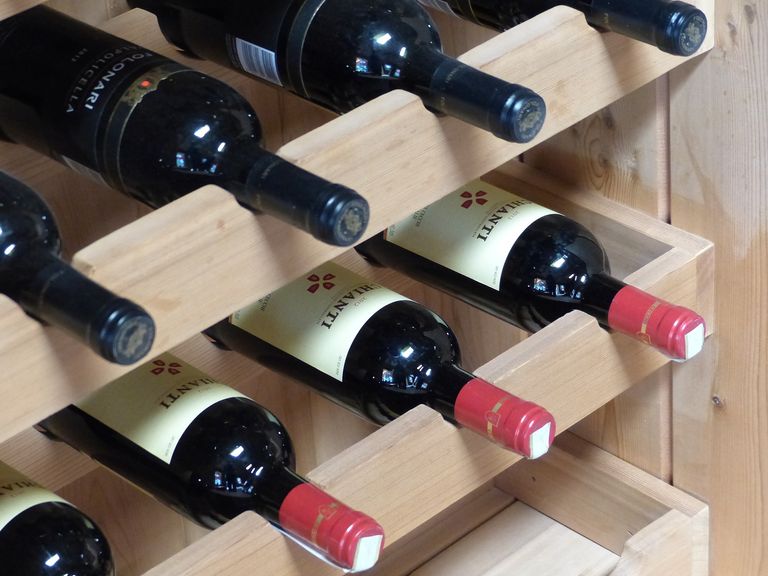
Aunque es un plato típico de fechas y celebraciones especiales, el pastel de carne es un plato fuerte versátil y digno de disfrutar incluso en días cotidianos. Y por si fuera poco, no tomará más de 15 minutos prepararlo y servirlo con deliciosos acompañantes saludables para bajar de peso rápido y cuidar la salud de los tuyos.

Although it is a typical dish for dates and special celebrations, the meatloaf is a versatile main course and worthy of enjoying even on everyday days. And as if that were not enough, it will not take more than 15 minutes to prepare and serve it with delicious healthy companions to lose weight quickly and take care of the health of your loved ones.
Receta para personas n. 4 / Recipe for people n. 4

600 g de pulpa de ternera
200 g de salchicha
100 g de remolacha
una cucharada de mantequilla
una cucharada de caldo
5 cucharadas de aceite de oliva
tomillo
jugo de limon
5 claras de huevo
4 yemas de huevo
1 cebolla pequeña
5 cucharadas de queso parmesano
2 cucharadas de arroz
sal
pimienta

600 g of veal pulp
200 g sausage
100 g of beets
a spoonful of butter
a spoonful of broth
5 tablespoons olive oil
thyme
lemon juice
5 egg whites
4 egg yolks
1 small onion
5 tablespoons parmesan cheese
2 tablespoons rice
salt
pepper

40' + 60' de cocción.
- La pulpa de ternera debe estar picada y el arroz ya hervido.
- Limpiar y lavar las remolachas varias veces.
- Retire el tallo y blanquee solo las hojas verdes en agua hirviendo con sal durante unos segundos.
- Escúrrelos, sécalos con toallas de papel y pícalos finamente.
- Pelar y picar la cebolla.
- En una sartén, calentar una cucharada de aceite y una cucharada de caldo y sofreír la cebolla picada durante cinco minutos.
- Hervir tres huevos durante cinco minutos.
- Escúrrelas y pásalas inmediatamente bajo el chorro de agua fría para detener la cocción: las yemas deben permanecer blandas.
- Calentar el horno a 200 grados.
- Retire la tripa de la salchicha y desmenúcela.
- En un bol ponemos la ternera, la salchicha, el arroz, tres cucharadas de parmesano, la cebolla, el tomillo, el huevo restante, la clara de huevo, sal y pimienta.
- Revuelva bien para combinar todos los ingredientes.
- Engrasa una hoja de papel de horno con aceite.
- Transfiera la mezcla de carne a la hoja de papel.
- Colocamos una lámina de film transparente encima y con un rodillo estiramos la mezcla hasta un grosor de 2 cm, dándole forma rectangular.
- Retire la película.
- Extender una capa de acelgas sobre el rectángulo de carne, espolvorear con el queso parmesano rallado restante y alinear los huevos duros en el centro, a lo largo.
- Con el papel de horno enrollar la carne, pincelarla con aceite y perfumarla con dos ramitas de tomillo.
- Envuelve completamente la carne en papel de horno y átala con hilo de cocina.
- Ponga el pastel de carne en una fuente para horno y hornee.
- Dejar cocinar durante veinte minutos, luego bajar la temperatura a 18' y continuar la cocción durante otros treinta minutos.
- Transcurrido el tiempo de cocción indicado, sacar el pastel de carne del horno y dejar reposar unos minutos, luego abrir el papel por un solo lado y, manteniendo el envoltorio inclinado, dejar salir los jugos de la cocción.
- Recójalo en una sartén.*
- Vuelva a sellar el paquete de pastel de carne.
- Retire el líquido de cocción contenido en la sartén a fuego lento diluyéndolo con unas cucharadas de agua y luego agréguelo a la salsa de la sartén.
- Llevar la salsa a ebullición y dejar que se reduzca un poco, luego agregar una cucharada de mantequilla y batir con un tenedor.
- A continuación, añade una pizca de tomillo picado y unas gotas de zumo de limón.
- Retire el papel del pastel de carne, córtelo en rodajas y coloque las rebanadas en un plato para servir ligeramente superpuestas.
- Espolvorear con la salsa y servir con una guarnición de patatas nuevas al horno con unas hojas de salvia fresca.

- The veal pulp must be minced and the rice already boiled.
- Clean and wash the beets several times.
- Remove the stem and blanch only the green leaves in boiling salted water for a few seconds. > * Drain them, dry them with paper towels and chop them finely.
- Peel and chop the onion.
- In a pan, heat a spoonful of oil and a spoonful of broth and stew the chopped onion for five minutes.
- Boil three eggs for five minutes.
- Drain them and immediately pass them under running cold water to stop the cooking: the yolks must remain soft.
- Heat the oven to 200 degrees.
- Remove the casing from the sausage and crumble it.
- In a bowl, put the veal, the sausage, the rice, three tablespoons of Parmesan, the onion, the thyme, the remaining egg, the egg white, salt and pepper.
- Stir thoroughly to combine all ingredients.
- Grease a sheet of baking paper with oil.
Transfer the meat mixture onto the sheet of paper.- Place a sheet of plastic wrap on it and with a rolling pin roll out the mixture to a thickness of 2 cm, giving it a rectangular shape.
- Remove the film.
- Spread a layer of chard over the rectangle of meat, sprinkle with the remaining grated Parmesan and line up the hard-boiled eggs in the centre, lengthwise.
- Using the baking paper, roll up the meat, brush it with oil and perfume it with two sprigs of thyme.
- Completely wrap the meat in baking paper and tie it with kitchen string.
- Put the meatloaf in a baking dish and bake.
- Leave to cook for twenty minutes, then lower the temperature to 18', and continue cooking for another thirty minutes.
- After the indicated cooking time, remove the meatloaf from the oven and let it rest for a few minutes, then open the paper on one side only and, keeping the wrapper tilted, let the cooking juices come out.
- Collect it in a pan.
- Reseal the packet of meatloaf.
- Remove the cooking liquid contained in the pan over low heat by diluting it with a few spoonfuls of water and then add it to the sauce in the pan.
- Bring the gravy to the boil and let it reduce slightly, then add a spoonful of butter and beat with a fork.
- Then add a pinch of chopped thyme and a few drops of lemon juice.
- Remove the paper from the meatloaf, slice it and arrange the slices on a serving plate slightly overlapping.
- Sprinkle with the sauce and serve with a side dish of oven-baked new potatoes with a few leaves of fresh sage.
Vino recomendado: Chianti. / Recommended wine: Chianti.

Chianti es uno de los vinos tintos italianos más conocidos y apreciados en todo el mundo. Se produce en la Toscana, y a menudo se asocia con la forma tradicional del recipiente que todavía se utiliza hoy en día para la venta, el fiasco, una botella con un cuello estrecho y una base muy ancha cubierta con paja.
El nombre Chianti hoy identifica un área geográfica (en su mayoría montañosa) de la Toscana central, caracterizada por diferentes condiciones geológicas, físicas y climáticas, entre las provincias de Florencia y Siena.
En esta zona específica se produce el vino Chianti Classico, que también forma parte de la DOCG Chianti (DM. 05/08/96 y posteriores modificaciones) pero que cuenta con una disciplina de producción independiente desde 1996.
El núcleo original de Chianti se encuentra dentro del área de Chianti Classico, a saber, los municipios de Gaiole, Radda y Castellina; es decir, la antigua provincia de Chianti definida por Fernando III de Toscana. La producción de Chianti tiene lugar en un área que incluye, además de las provincias de Florencia y Siena, también las provincias de Arezzo al este de Chianti, Pisa y Pistoia al oeste y Prato (al norte).

Chianti is one of the best known and appreciated Italian red wines throughout the world. It is produced in Tuscany, and is often associated with the traditional shape of the container that is still used for sale today, the fiasco, a bottle with a narrow neck and a very wide base covered with straw.
The name Chianti today identifies a (mostly mountainous) geographical area of central Tuscany, characterized by different geological, physical and climatic conditions, between the provinces of Florence and Siena. Chianti Classico wine is produced in this specific area, which is also part of the DOCG Chianti (DM 05/08/96 and subsequent modifications) but has had an independent production discipline since 1996.
The original core of Chianti is found within the Chianti Classico area, namely the municipalities of Gaiole, Radda and Castellina; that is, the ancient province of Chianti defined by Ferdinand III of Tuscany. Chianti production takes place in an area that includes, in addition to the provinces of Florence and Siena, also the provinces of Arezzo to the east, Chianti, Pisa and Pistoia to the west, and Prato (to the north).
The production of Chianti takes place in an area which includes, in addition to the provinces of Florence and Siena, also the provinces of Arezzo to the east of Chianti, Pisa and Pistoia to the west and Prato (to the north).
Translated with www.DeepL.com/Translator (free version)

Fuentes / Sources:
Fuente de la imagen inicial del post / Source of the initial image of the post: https://www.fattoincasadabenedetta.it/ricetta/polpettone-con-le-bietole/
Fuente de la imagen final del post. / Source of the final image of the post: Pixabay.
Y como siempre me despido de todos con un:
And as always I bid you all farewell with a:
